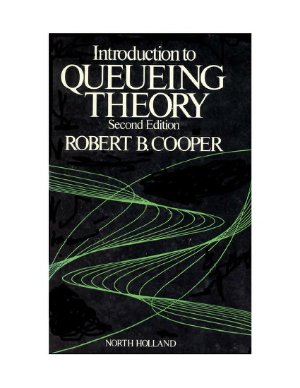Издательство North Holland, 1981, -361 pp.
This is a revised, expanded, and improved version of my textbook, Introduction to Queueing Theory. As before, it is written primarily for seniors and graduate students in operations research, computer science, and industrial engineering; and as before, the emphasis is on insight and understanding rather than either cookbook application or fine mathematical detail. Although it has been structured for use primarily as a textbook, it should be a useful reference for re- researchers and practitioners as well. The second edition reflects the feedback of students and instructors who have used the first edition (which began as a set of notes for an in-house course I taught at Bell Laboratories), as well as my own experience teaching from the book at the Georgia Institute of Technology (in the School of Industrial and Systems Engineering and the School of Information and Computer Science), the University of Michigan (in the Department of Industrial and Operations Engineering), the New Mexico Institute of Mining and Technology (in the Department of Mathematics), and Florida Atlantic University (in the Department of Computer and Information Systems). The objective of the second edition is to improve on the first edition with respect to clarity, comprehensiveness, currency, and, especially, its utility both for teaching and, self-study.
Scope and Nature of Queueing Theory.
Review of Topics from the Theory of Probability and Stochastic Processes.
Birth-and-Death Queueing Models.
Multidimensional Birth-and-Death Queueing Models.
mbedded-Markov-Chain Queueing Models.
Simulation of Queueing Models.
This is a revised, expanded, and improved version of my textbook, Introduction to Queueing Theory. As before, it is written primarily for seniors and graduate students in operations research, computer science, and industrial engineering; and as before, the emphasis is on insight and understanding rather than either cookbook application or fine mathematical detail. Although it has been structured for use primarily as a textbook, it should be a useful reference for re- researchers and practitioners as well. The second edition reflects the feedback of students and instructors who have used the first edition (which began as a set of notes for an in-house course I taught at Bell Laboratories), as well as my own experience teaching from the book at the Georgia Institute of Technology (in the School of Industrial and Systems Engineering and the School of Information and Computer Science), the University of Michigan (in the Department of Industrial and Operations Engineering), the New Mexico Institute of Mining and Technology (in the Department of Mathematics), and Florida Atlantic University (in the Department of Computer and Information Systems). The objective of the second edition is to improve on the first edition with respect to clarity, comprehensiveness, currency, and, especially, its utility both for teaching and, self-study.
Scope and Nature of Queueing Theory.
Review of Topics from the Theory of Probability and Stochastic Processes.
Birth-and-Death Queueing Models.
Multidimensional Birth-and-Death Queueing Models.
mbedded-Markov-Chain Queueing Models.
Simulation of Queueing Models.

